The flag of Tunisia is one of the world’s oldest flags.
Tunisia’s flag was adopted on July 3, 1959.
The flag is very similar to the original naval flag of
the kingdom of Tunis that was used by Al-Husayn II
ibn Mahmud, the monarch of Tunis in the 1830’s.
One visual difference between the two flags is a more
narrowed crescent than in the current flag of Tunisia.
The flag of the Ottoman Navy, which was used
1793-1844, also had a red background but had an
eight pointed cluster type star and a moon while the
current flag has a five-pointed star.
The flag of Tunisia has a description that is an exercise
in symbolism and history. The flag itself is bright red.
There is a white disc, or circle, that is in the middle of
the flag. This disc holds both a crescent and a star.

Red, the color of the flag, is a traditional color that
symbolizes Islam. It also is symbolic of the resistance
against the Turkish supremacy. Red was the color the
Ottoman Empire used who ruled Tunisia from 16th
century to 1881.
http://www.tourismtunisia.com/flag-of-tunisia/
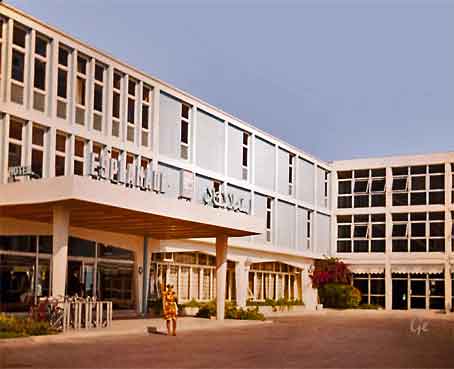
Mor utenfor hotel Esplanade i Monastir.
Monastir, also called Mīstīr (Arabic: مـنسـتير
Mīstīr, from the Greek μοναστήριον "hermit's cell, monastery"),
is a city on the central coast of Tunisia, in the Sahel area,
It is 20 kilometres (12 miles) south of Sousse and 162
kilometres (101 miles) south of Tunis. Traditionally a fishing
port, Monastir is now a major tourist resort. Its population is
about 93,306. It is the capital of Monastir Governorate.
https://en.wikipedia.org/wiki/Monastir,_Tunisia
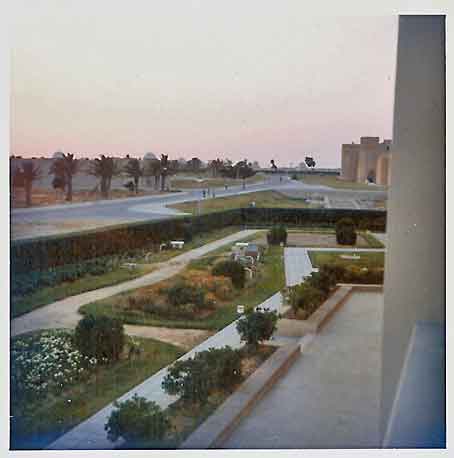
Utsikten fra rommet mor og jeg hadde.
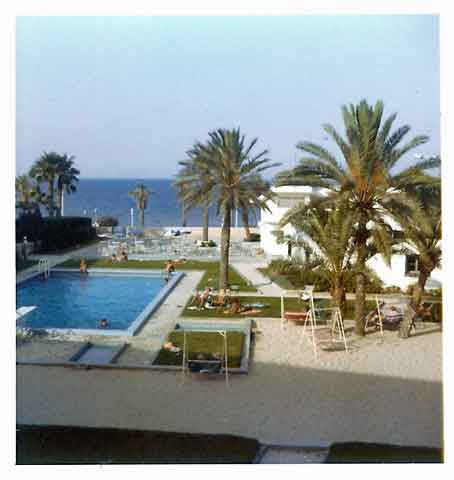
Utsikten fra rommet til Jan Erik
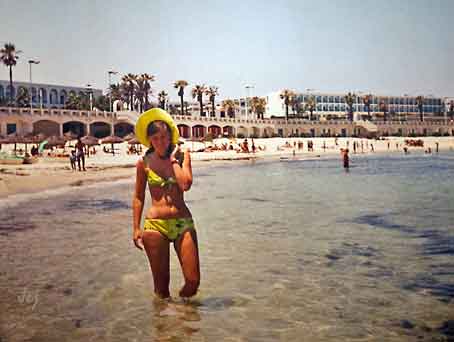
Fin badestrand rett nedenfor hotellet.
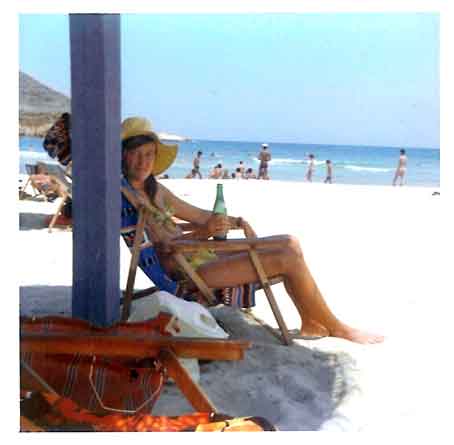
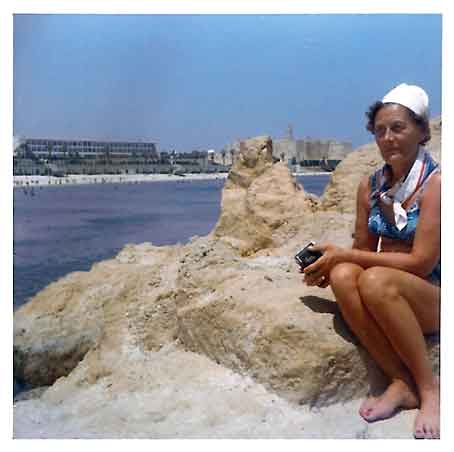
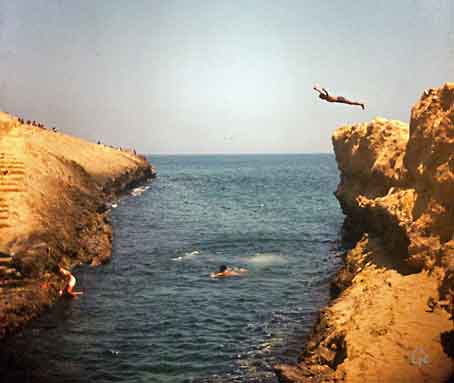
De lokale gutta tøffer seg for turistene
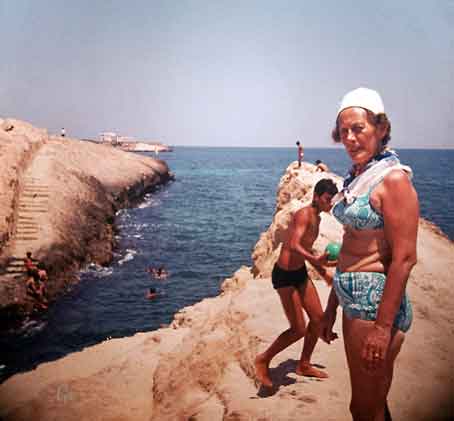

Kartago
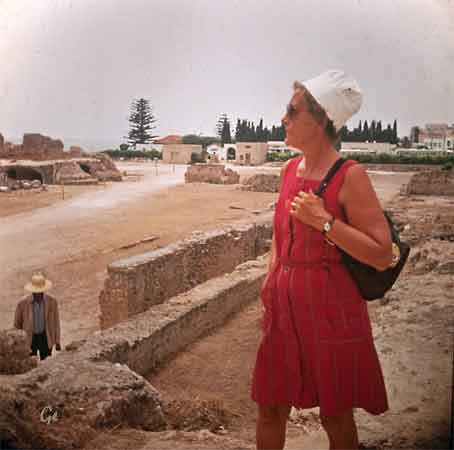
Karthago
"Ceterum censeo Carthaginem esse delendam" or "Ceterum
autem censeo Carthaginem esse delendam" (English:
"Furthermore, (moreover) I consider that Carthage must be
destroyed") often abbreviated to "Ceterum censeo",
"Carthago delenda est", or "Delenda est Carthago" (English: "Carthage must be destroyed") is a Latin oratorical phrase
of the Roman Republic in the 2nd Century BC prior to the
Third Punic War against Carthage, by the party advocating
destruction of Rome's ancient rival Carthage, which was
thought to be rebuilding its capacity for further warfare.
The phrase is associated with the Roman senator Cato the
Elder, who is said to have used it as the conclusion to all his
speeches.
Punic Wars, as they vied for dominance with the seafaring Phoenician city-state of Carthage in North
Africa (modern day Tunisia), they suffered a number of humiliations and damaging reverses in the course of
these engagements, especially at the Battle of Cannae
(216 BC). This grew into an attitude of seeking
vengeance and total victory, which was expressed by
these phrases. The city of Carthage was indeed finally
razed by the Roman general Scipio Aemilianus after the
Third Battle of Carthage in 146 BC, and its entire
remaining population was sold into slavery. It thus never
again posed a threat to Rome—at least until taken over
by the Vandals, who looted Rome in 455.
The modern legend that the city was sown with salt
reflects the perceived savagery of its destruction.
https://en.wikipedia.org/wiki/Carthago_delenda_est
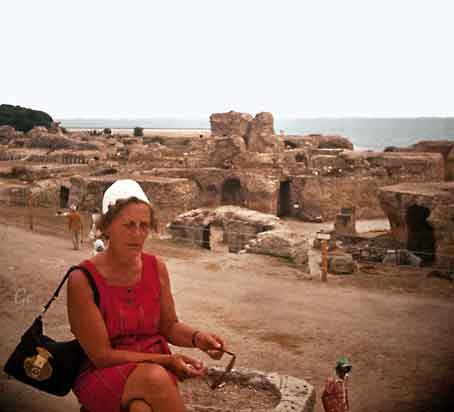
Karthago
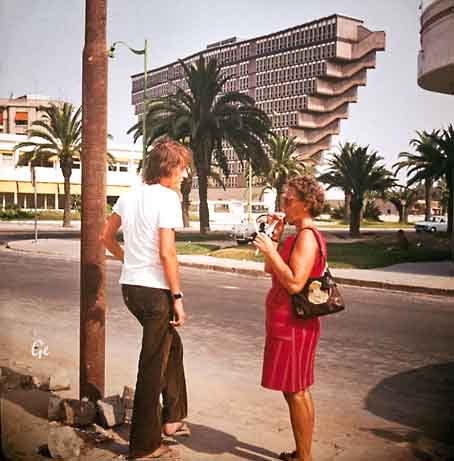
Hôtel du Lac in Tunis was built in the 1960s by the Lake
of Tunis. The ten-story building is unique with its
distinctive architecture and concrete construction, an
icon of brutalist architecture. By protruding each floor
at both ends to a respective room width, this design
concept resulted a building that has a top level twice as
wide than its ground level.
http://architectuul.com/architecture/hotel-du-lac
city of Tunisia. The greater metropolitan area of Tunis,
often referred to as Grand Tunis, has some 2,700,000
inhabitants.
Situated on a large Mediterranean Sea gulf (the Gulf of
Tunis), behind the Lake of Tunis and the port of La
Goulette (Ḥalq il-Wād), the city extends along the coastal
plain and the hills that surround it. At its core lies its
ancient medina, a World Heritage Site.
East of the medina through the Sea Gate (also known as
the Bab el Bhar and the Porte de France) begins the
modern city, or Ville Nouvelle, traversed by the grand
Avenue Habib Bourguiba (often referred to by popular
where the colonial-era buildings provide a clear contrast
to smaller, older structures. Further away by the sea lie
the suburbs of Carthage, La Marsa, and Sidi Bou Said.
As the capital city of the country, Tunis is the focus of
Tunisian political and administrative life; it is also the
centre of the country's commercial activity.
The expansion of the Tunisian economy in recent decades
is reflected in the booming development of the outer city
where one can see clearly the social challenges brought
about by rapid modernization in Tunisia.
https://en.wikipedia.org/wiki/Tunis


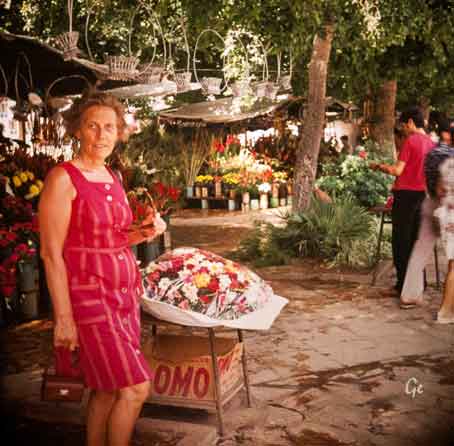
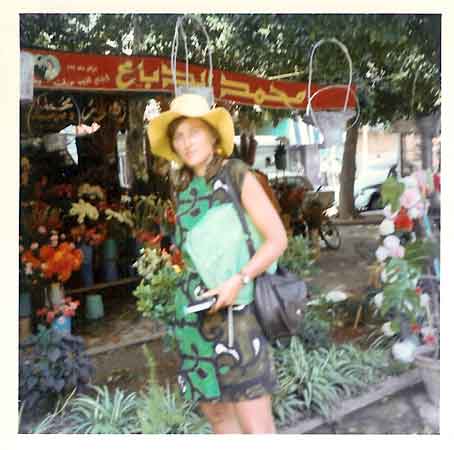



Jan i Tunis
'the Greatest Desert') is the largest hot desert and the
third largest desert in the world after Antarctica and
the Arctic. Its area of 9,200,000 square kilometres (3,600,000 sq mi) is comparable to the area of the
United States.
The desert comprises much of North Africa, excluding
the fertile region on the Mediterranean Sea coast, the
Atlas Mountains of the Maghreb, and the Nile
Valley in Egypt and Sudan. It stretches from
the Red Sea in the east and the Mediterranean in the
north to the Atlantic Ocean in the west, where the
landscape gradually changes from desert to coastal
plains. To the south, it is bounded by the Sahel, a belt
of semi-arid tropical savanna around the Niger River
valley and the Sudan Region of Sub-Saharan Africa.
The Sahara is mainly rocky hamada (stone plateaus),
Ergs (sand seas - large areas covered with sand dunes)
form only a minor part, but many of the sand dunes
are over 180 metres (590 ft) high.
Wind or rare rainfall shape the desert features: sand
dunes, dune fields, sand seas, stone plateaus, gravel
plains (reg), dry valleys (wadi), dry lakes (oued), and
Richat Structure in Mauritania. Several deeply dissected
mountains, many volcanic, rise from the desert, including
the Aïr Mountains, Ahaggar Mountains, Saharan Atlas,
Tibesti Mountains, Adrar des Iforas, and the Red Sea hills.
The highest peak in the Sahara is Emi Koussi, a shield
volcano in the Tibesti range of northern Chad.
https://en.wikipedia.org/wiki/Sahara
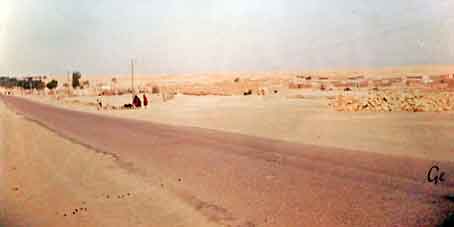
Veien gjennom Sahara

Bare 58 km fra Algerie

Kamelene er på plass

Salg av "ørkenroser"
rose-like formations of crystal clusters of gypsum or baryte which include abundant sand grains.
The 'petals' are crystals flattened on the crystallographic
axis, fanning open in radiating flattened crystal clusters.
The rosette crystal habit tends to occur when the crystals
form in arid sandy conditions, such as the evaporation of
a shallow salt basin. The crystals form a circular array of
flat plates, giving the rock a shape similar to a rose
blossom.
Gypsum roses usually have better defined, sharper edges
than baryte roses. Celestine and other bladed evaporite
appear either as a single rose-like bloom or as clusters
of blooms, with most sizes ranging from pea sized to
4 inches (10 cm) in diameter.
The ambient sand that is incorporated into the crystal
structure, or otherwise encrusts the crystals, varies
with the local environment. If iron oxides are present,
the rosettes take on a rusty tone.
The desert rose may also be known by the names:
sand rose, rose rock, selenite rose, gypsum rose and
baryte (barite) rose.
https://en.wikipedia.org/wiki/Desert_rose_(crystal)
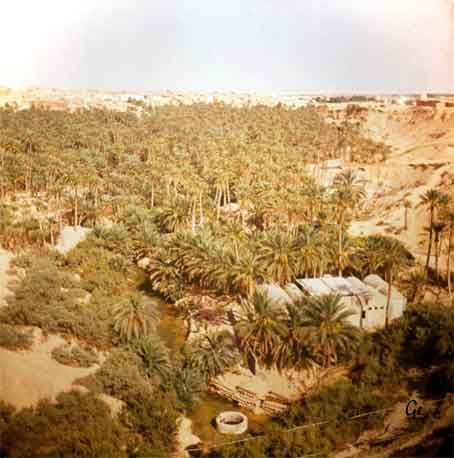
En oase
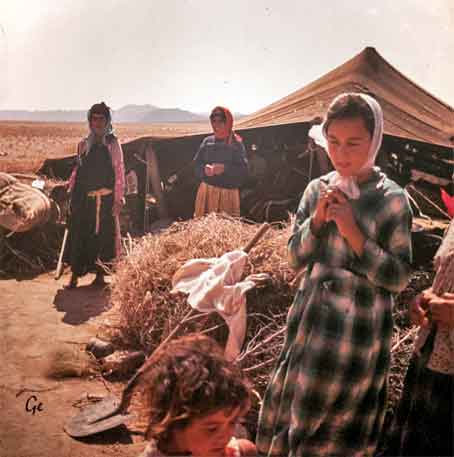
Nomader
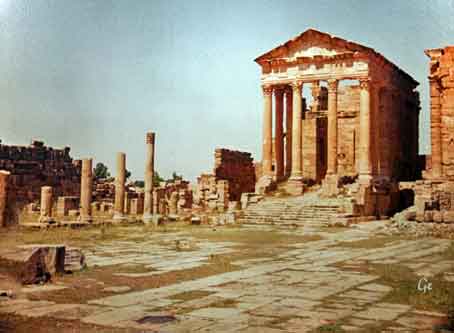
The archaeological site of Sbeitla is an archaeological site
in Sbeitla, in north-central Tunisia. It represents the Roman
ruins of Sufetula, and contains the best preserved Roman
forum temples in Tunisia. It was excavated and restored
between 1906 and 1921.
The city was founded, if not already in existence, during the
reign of Emperor Vespasian. Sufetula was the theatre of the
great confrontation between Byzantines and Arabs in 647,
setting the stage for the later Muslim conquest of the diocese
of Sufetula and further conquests in southern Europe.
https://en.wikipedia.org/wiki/Archaeological_site_of_Sbeitla
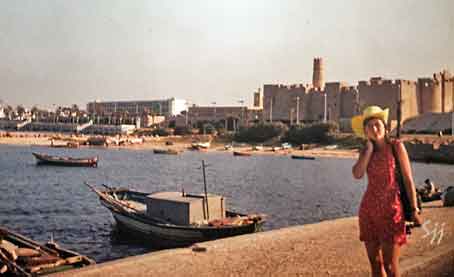
Vi er tilbake i Monastir etter ørkenturen.
I bakgrunnen sees Le Ribat
Le ribat de Monastir (arabe : رباط المنستير) est une imposante forteresse tunisienne située au bord de
la mer Méditerranée, dans la ville de Monastir.
Considéré comme le ribat le plus ancien et le plus
important du Maghreb1, il est regardé comme le
monument phare de Monastir.
https://fr.wikipedia.org/wiki/Ribat_de_Monastir

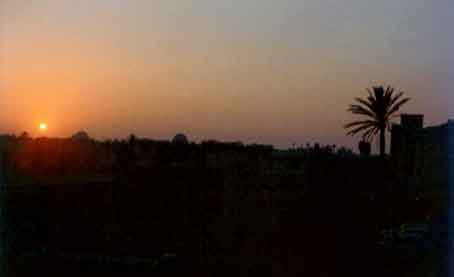
En kopp kaffe i skyggen på hotellet er
godt etter varmen i Sahara.
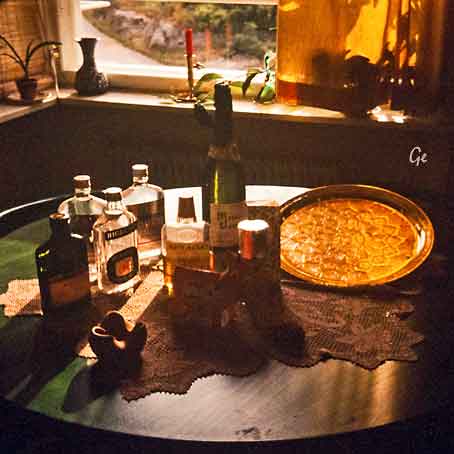
Beskjeden handling i Tunisia
Tunisie), officially the Tunisian Republic
(Arabic: الجمهورية التونسية
in North Africa, covering 165,000 square kilometres
(64,000 square miles). Its northernmost point, Cape
Angela, is the northernmost point on the African continent.
It is bordered by Algeria to the west and southwest, Libya
to the southeast, and the Mediterranean Sea to the north
and east. Tunisia's population was estimated to be just
under 11 million in 2014. Tunisia's name is derived from
its capital city, Tunis, which is located on Tunisia's
northeast coast.Geographically, Tunisia contains the
eastern end of the Atlas Mountains and the northern
reaches of the Sahara desert.
Much of the rest of the country's land is fertile soil.
Its 1,300 kilometres (810 miles) of coastline includes the
African conjunction of the western and eastern parts of
the Mediterranean Basin and, by means of the Sicilian Strait and Sardinian Channel, features the African
mainland's second and third nearest points to Europe after Gibraltar.
https://en.wikipedia.org/wiki/Tunisia